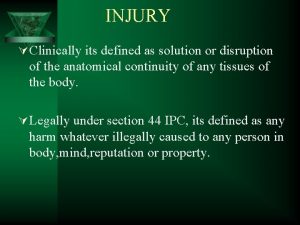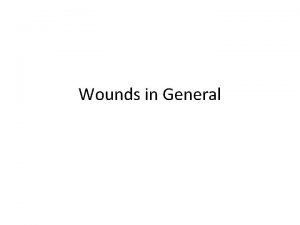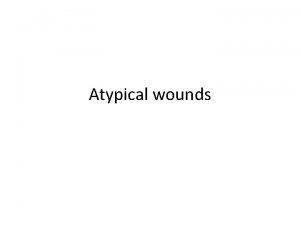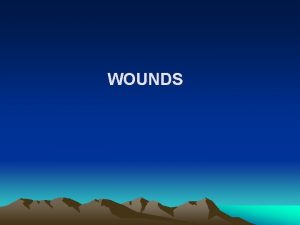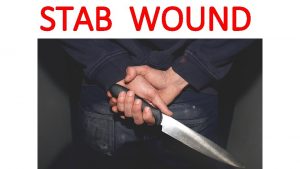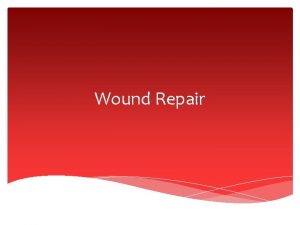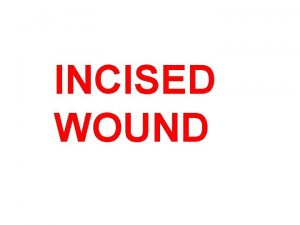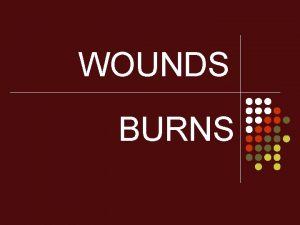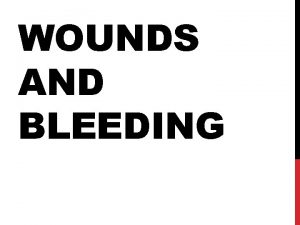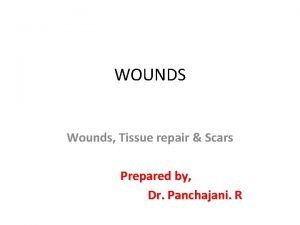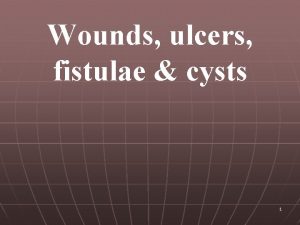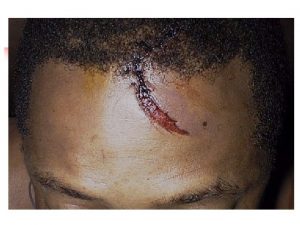Wounds WOUNDS A wound is an injury that















- Slides: 15

Wounds

WOUNDS A wound is an injury that damages the body’s tissues. The two greatest concerns in regards to wounds include excessive bleeding and infection.

SIGNS OF INFECTION Redness Swelling Pain Heat Pus Red streaks coming from the wound

TYPES OF WOUNDS - CLOSED WOUNDS A closed wound is an injury that causes damage to the tissue under the skin. Closed wounds are caused when the body hits against a blunt object, such as in a bump or fall. A closed wound will usually heal on its own in a few weeks. • Contusion - bruise • Hematoma - also called blood tumors or blood blisters, caused by damage to a vessel that causes blood to collect under the skin. • Internal - caused by crushing injury to the body

TYPES OF WOUNDS - OPEN WOUNDS 1. 2. 3. 4. 5. 6. Incisions Lacerations Abrasions Punctures Avulsions Amputations

INCISION • This cut is caused by a sharp object such as a knife, scissors, or razor • The edges are smooth and regular • If the cut is deep, bleeding can be heavy and can lead to excessive blood loss and shock • Damage to muscles, tendons, and nerves may also occur

LACERATION • Involves tearing of the tissues by way of excessive force • The wound is often has jagged or irregular edges • Bleeding maybe heavy and if the wound is deep, it may lead to infection

ABRASION • The surface and sometimes deeper layers of the skin is scraped off • Bleeding is usually limited, but infection must be prevented because dirt and contaminants often enter the wound.

PUNCTURE • Caused by a sharp object such as a pin, nail, or pointed instrument. • External bleeding is limited, but internal bleeding can be severe • Chance of infection especially tetanus is the tetanus bacteria has entered the wound

AVULSION • Occurs when tissue is torn or ripped away from the victim’s body • It can result in a piece being torn and hanging from the ear, nose, hand, or any other body part • Bleeding is normally profuse • It is important to preserve any body part while caring for the patient

AMPUTATIONS • Occurs when a body part is cut off or torn off • Bleeding can be extensive • Care must be taken with the amputated object • Wrap it in a cool moist dressing (use sterile water or saline if available) Place it in a plastic bag and then in ice water

MINOR OPEN WOUNDS Minor wounds are shallow and produce very little blood. They are not life-threatening and can be treated at home. Untreated, or improperly treated, minor wounds can become infected or can cause tetanus

MAJOR OPEN WOUNDS It is important to act quickly when treating a patient with a major wound because a patient can bleed to death in a short period of time Care for a major wound includes stopping the bleeding and then cleaning and covering. When caring for major wounds, the health care worker should also check the patient’s vital signs, and watch for signs of shock.

DRESSINGS A dressing is a sterile covering for a wound or injury. Dressings are used to: ▫ stop bleeding ▫ prevent infection ▫ absorb secretions ▫ treat pain Gauze pads are the most common materials used for dressings. However, in an emergency situation, any clean cloth can be used.

BANDAGES A bandage is material used to secure dressings and splints. Bandages should be tight enough to control bleeding and to hold a dressing in place. However, they should not interrupt blood circulation. Three popular types of bandages are: ▫ Triangular ▫ Roller gauze ▫ Elastic
 Intentional injury examples
Intentional injury examples Tôn thất thuyết là ai
Tôn thất thuyết là ai Phân độ lown ngoại tâm thu
Phân độ lown ngoại tâm thu Chiến lược kinh doanh quốc tế của walmart
Chiến lược kinh doanh quốc tế của walmart Gây tê cơ vuông thắt lưng
Gây tê cơ vuông thắt lưng Block nhĩ thất độ 2 mobitz 1
Block nhĩ thất độ 2 mobitz 1 Tìm độ lớn thật của tam giác abc
Tìm độ lớn thật của tam giác abc Sau thất bại ở hồ điển triệt
Sau thất bại ở hồ điển triệt Thể thơ truyền thống
Thể thơ truyền thống Hãy nói thật ít để làm được nhiều
Hãy nói thật ít để làm được nhiều Thơ thất ngôn tứ tuyệt đường luật
Thơ thất ngôn tứ tuyệt đường luật Chapter 17:7 providing first aid for heat exposure
Chapter 17:7 providing first aid for heat exposure Concealed puncture wounds
Concealed puncture wounds Cavitation bullet wounds
Cavitation bullet wounds Kinds of wounds with pictures
Kinds of wounds with pictures Jackson's theory of thermal burns
Jackson's theory of thermal burns












